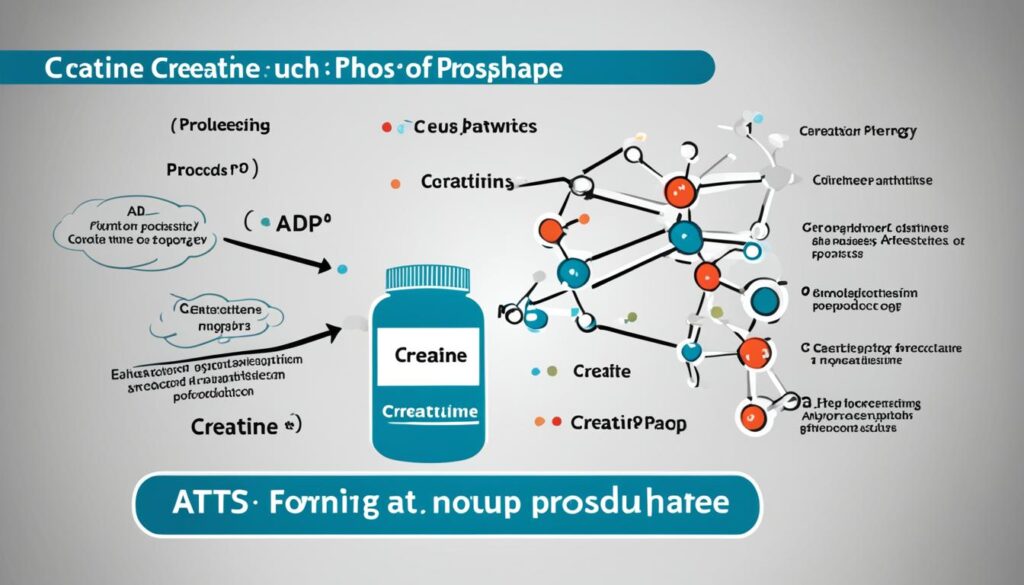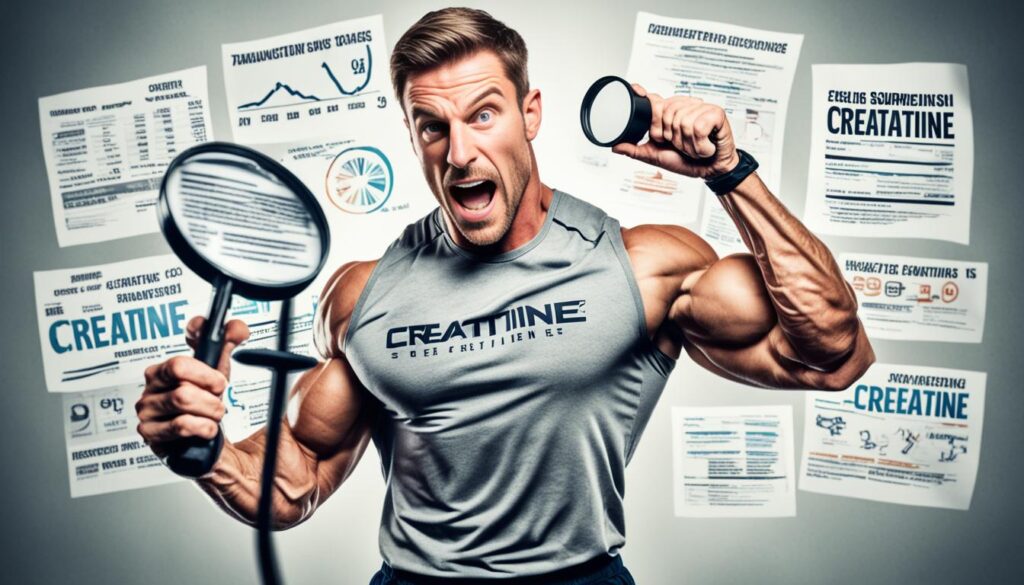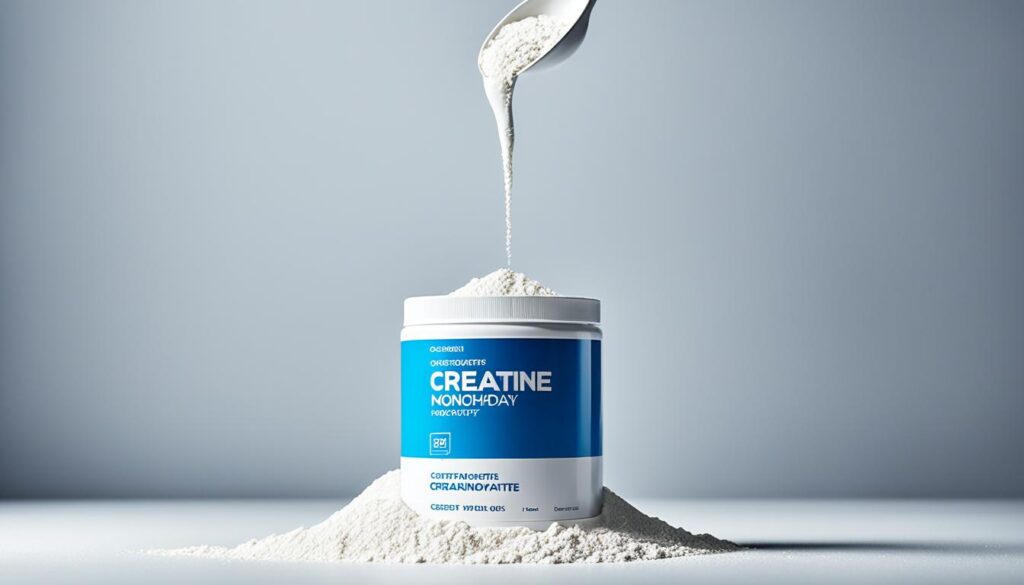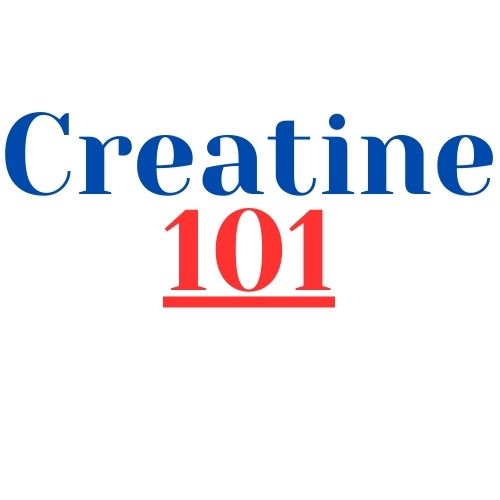Did you know that nearly every athlete seeking to enhance their performance has considered, if not used, one particular supplement? That supplement is none other than creatine, a powerhouse behind the impressive feats of strength and endurance in sports. Renowned for its significant Creatine benefits, this natural compound boosts athletic performance by serving as a potent energy booster. The most striking fact about creatine is its ability to increase high-intensity exercise performance by as much as 15%. This is not just a mere percentage—it is the difference between second place and setting records, between attaining personal bests and surpassing thresholds previously thought unreachable.
My interest in the world of athletics and supplements led me to explore how creatine functions as a fundamental exercise supplement, driving the production of the energy molecule ATP. It’s remarkable to uncover that nearly 95% of the body’s creatine is stored right where it’s most needed—in our muscles. This strategic reserve is precisely what lends athletes that extra surge in muscle strength and power output when engaging in rigorous physical activities. Whether it’s lifting heavier, sprinting faster, or jumping higher, creatine stands as a formidable ally in the world of sports performance.
Key Takeaways
- Creatine’s ability to enhance energy production is fundamental for athletes striving for peak performance.
- Supplementation can lead to significant improvements in power output and muscle strength.
- Combining creatine with resistance training may increase testosterone levels, further boosting performance.
- With exhaustive scientific studies backing its efficacy, creatine is one of the most trusted and reliable exercise supplements available.
- The safe and effective nature of creatine makes it a staple in the athletic community.
Understanding Creatine and Its Importance in Sports
Within the competitive realm of sports, creatine has emerged as a pivotal molecule in the quest to enhance athletic prowess and facilitate muscle gain. Often, my discussions with professional athletes reveal a substantial reliance on this compound for its benefits in energy metabolism and ATP production, particularly during high-intensity training moments that define the outcomes of their sporting events.
The Fundamentals of Creatine as an Energy Molecule
Grounded in my exploration of biochemistry and exercise physiology, I have come to appreciate creatine’s role as a substantial energy molecule. Creatine phosphate’s ability to donate phosphate groups to ADP, thus regenerating ATP, is a biological marvel. This process is essential for sustaining the explosive, high-intensity performance that many sports demand. It’s a fundamental mechanism that echoes throughout gyms and sports complexes, heralding creatine’s acclaimed role in energy metabolism.
Why Athletes Turn to Creatine for Enhanced Performance
Having conversed with athletes across a spectrum of disciplines, I’ve noted a consistent trend: the strategic use of creatine supplementation. It’s not merely about the immediate surge of energy; it’s the long-term gains—increased muscle strength and the accumulative advantage of better training adaptations. Understandably, creatine is not just another supplement; it’s a scientifically supported enhancer of high-intensity performance. The attestation to its effectiveness can be seen in improved sprint timings, greater weightlifting repetitions, and the agility to execute rapid jumps. It’s this multifaceted impact that underscores why athletes are dedicated to incorporating creatine in their regimen.
As we advance through this exploration of creatine and its dynamic within the athletic realm, one can’t help but be drawn to its compelling science—an energy parceler deftly navigating the demands of muscle metabolism.
The Science of Creatine in ATP Production

The molecular intricacies underlying energy production in cells, especially during high-octane activities, are quite fascinating. I have delved deeply into understanding how the body harnesses creatine phosphate for swift ATP replenishment. This exploration has led to valuable insights on amplifying muscular strength and sustaining high-intensity exercise performance, which I’m excited to share.
How Creatine Phosphate Donates a Phosphate Group to ADP
Amidst rigorous physical exertion, our cells crave for rapid energy production to maintain intense efforts. Creatine supplementation strategically increases the body’s reservoir of creatine phosphate, a crucial player in energy regeneration. This compound generously donates a phosphate group to the energy-depleted molecule ADP, gracefully converting it back to ATP – indispensable for ongoing cellular activities.
Maximizing Muscular Creatine Stores for Athletic Benefits
Enriching the muscles with ample creatine stores through supplementation could dramatically enhance an athlete’s physical output. A well-nourished muscle fiber brimming with creatine phosphate is equivalent to a well-armed warrior ready for battle. It ensures formidable strength, resilience during sprint sequences, and an overall capability for more rigorous and extended workouts.
Examining the Impact of Creatine on High-Intensity Workouts
As an avid supporter of sports nutrition, I’ve observed considerable interest in the use of creatine for boosting endurance and sprint performance among athletes. The profound effects of creatine supplementation extend particularly to high-intensity training, where the body’s demand for rapid energy output is at its peak. Traditionally, creatine is recognized as a powerful energy booster, helping athletes surpass their typical training thresholds and achieve new records.
The link between creatine and enhanced athletic prowess is well-documented, indicating remarkable improvements in activities such as short-distance sprints, resistance training, and explosive power motions. My analysis suggests that these benefits are attributed to creatine’s role in replenishing ATP, the essential energy molecule, which is crucial during bouts of intense physical activity.
| Workout Type | Without Creatine | With Creatine |
|---|---|---|
| Sprint Performance | Baseline Times | Reduced Completion Times |
| Cycling Power | Standard Output | Increased Power Output |
| Weightlifting Load | Conventional Limits | Enhanced Training Loads |
| Jumping Capability | Fixed Performance | Improved Height and Frequency |
Delving into the multifaceted world of soccer, I’ve noticed that players often resort to creatine to excel in rapid successions of sprinting and to enhance their overall performance during agile movements. The transformative influence of this compound not only aligns with personal observation but is also corroborated by an extensive body of scientific research.
Moreover, these findings are not exclusive to traditional sports; individuals engaged in high-intensity interval training (HIIT) report notable improvements in their workout efficiency, further demonstrating creatine’s versatility as a performance enhancer.
As the evidence accumulates, the consensus within the fitness community is clear – creatine stands as a cornerstone in the domain of sports nutrition for those seeking to maximize their performance and dominate high-intensity workouts.
Amplifying Strength and Power: Creatine’s Effect on Muscle

The potent impact of creatine supplementation on physical prowess is not to be underestimated. Through meticulous research, it’s become increasingly evident that integrating creatine into one’s nutrition regimen profoundly bolsters muscle strength enhancements and contributes to the sustenance of muscle mass retention. This augmentation is particularly beneficial for those engaged in ongoing strength training and repetitive resistance exercises.
Research-Backed Muscle Strength Enhancements Through Creatine Supplementation
Statistical findings from a myriad of studies illuminate the quantifiable benefits that creatine supplementation adds to strength training routines. Notably, an impressive leap in strength, quantified as a 15% increase in loading weights during 1-rep max bicep curls, has been linked to regular creatine intake. Enhanced athletic performance doesn’t halt there; improvements encompass max squat and bench press capabilities as well, demonstrating creatine’s pronounced effect on strength enhancement.
Long-Term Muscle Mass Retention and the Role of Creatine
In the world of athletic training, the significance of long-term muscle mass retention is paramount. Creatine emerges as a crucial ally in this realm, particularly when paired with comprehensive resistance exercises. The alliance of creatine with resistance training is shown to furnish athletes with escalated workout outputs—inferring not only increased explosive power but also the capacity to endure a higher volume of repetitions during strenuous workout sessions.
As someone keenly focused on the interplay between supplements and muscle dynamics, I’ve observed firsthand the profound implications of creatine on muscle development. From fledgling gym-goers to seasoned athletes, the consensus on creatine’s efficacy is clear—it’s a pivotal component of training regimens geared toward optimising strength and power. Through judicious creatine supplementation, athletes can expect marked gains, fostering an environment conducive to continual muscle development and peak performance.
Creatine’s Role in Energy Production Athletics
In the realm of competitive sports, creatine’s role in athletics is incontrovertible—not only as a booster for energy production but also as an essential element for muscle performance and sports nutrition. As an athlete myself, the inclusion of creatine into my daily regimen has been a game-changer, fostering training adaptation that keeps me at my peak during intense workouts. Let’s delve deeper into how this substance fuels athletic prowess.
The ability to repeatedly perform at high intensity hinges on the body’s capacity to rapidly regenerate ATP—the energy currency that dictates cellular function, especially in muscle cells. With regular creatine supplementation, I have noticed a remarkable improvement in my short burst energy outputs, which are crucial for both training and performance.
It’s worth discussing the transformative impact creatine supplementation can have on any athlete’s performance:
- Increase in Creatine Phosphate Stores: Leads to a sustained energy supply for explosive movements.
- Enhanced Muscle Power Output: Supports greater force production in movements like sprinting and lifting.
- Accelerated Training Adaptation: Promotes a more rapid physiological response to strength and endurance training.
Moreover, these effects are not just anecdotal musings but are firmly backed by science. Here is a snapshot of what studies have revealed:
| Metric | Baseline | Post-Creatine Supplementation | Source |
|---|---|---|---|
| ATP Restoration Speed | Standard | Increased | J. Sports Sci. & Med. |
| Power Output | Good | Very Good to Excellent | Int. J. Sport Nutr. & Exerc. Metab. |
| Adaptation to High-Intensity Training | Moderate | Significantly Improved | Med. Sci. Sports Exerc. |
Integrating creatine into an athlete’s nutrition plan substantively contributes to energy production, and this, my fellow athletes, is perhaps one of the most persuasive arguments for its adoption. It’s not merely about ingesting a supplement; it’s about embracing a scientifically validated strategy that amplifies athletic capacity and endurance, producing tangible improvements in the gym and on the playing field.
Optimizing Sports Performance with Creatine Supplementation

As someone deeply invested in the nuances of sports performance optimization, I’ve integrated creatine supplementation into my routine to leverage its impressive benefits. A judicious approach to dosage and timing can significantly enhance my exercise performance and muscle strength.
Dosage and Timing Recommendations for Athletes
To lay the foundation for peak athletic prowess, I follow a structured plan for my creatine intake. The initial phase includes a loading period, featuring a higher dosage to rapidly saturate my muscle stores. The subtleties of timing are equally crucial, ensuring that each dose aligns perfectly with my body’s optimal absorption windows. Here’s a thorough breakdown:
| Phase | Dosage | Frequency | Duration |
|---|---|---|---|
| Loading | 20-25 grams per day | Divided into 5-gram servings | 5-7 days |
| Maintenance | 3-5 grams per day | Once daily | Long-term |
Protein and Carbohydrate Synergy with Creatine for Improved Absorption
To maximize my body’s uptake of creatine, I harness the synergy between protein, carbohydrates, and creatine. This strategic union not only fortifies my muscle creatine stores but also amplifies the anabolic response essential for muscle repair and growth. Integrating this protein-carbohydrate synergy into my post-workout recovery or with meals supports my overall regimen, pushing my athletic limits further with every training session.
- Post-training shakes: A blend of creatine with protein and high-glycemic carbohydrates to augment absorption and recovery.
- Meal pairings: Incorporate creatine with protein-rich meals alongside a sufficient carbohydrate source to enhance assimilation and muscle recovery.
Steered by research and practical experimentation, these methods of creatine supplementation, paired with carefully planned dosage and optimal timing, coalesce into a formidable strategy in my arsenal—catapulting my sports performance optimization to new heights.
Challenging Myths: Debunking Common Misconceptions About Creatine

As an advocate for sports nutrition education, I find it imperative to clear the haze of misinformation that surrounds the use of creatine. Misguided beliefs often lead to exercise supplement misunderstandings, but through scientific scrutiny, we can illuminate the truth about creatine’s efficacy and safety.
Separating Creatine Facts from Fiction in Athletic Circles
Contrary to popular myths, creatine is not a synthetic and dangerous chemical concocted to artificially enhance performance. In fact, it is a naturally occurring compound that plays a crucial role in the body’s energy systems. The tales of it causing harm are born from a lack of understanding and fear-mongering, not from empirical evidence. Allow me to set the record straight – creatine is a well-researched supplement boasting a long history of safe use in sports nutrition.
Addressing Concerns Over Creatine’s Safety and Efficacy
When it comes to debunking creatine myths, the conversation often tends toward questioning its safety. Through the dissemination of unfounded rumors, a number of myths have arisen, including fears around kidney and liver damage, dehydration, and muscle cramping. However, scores of scientific studies stand in testament to its safety profile and high efficacy, particularly when used responsibly by healthy individuals.
| Myth | Fact |
|---|---|
| Creatine causes kidney damage | No evidence of harm in healthy individuals |
| Creatine leads to dehydration and cramps | Studies show no increased risk and may improve hydration |
| Creatine is a steroid and illegal | Creatine is not a steroid and is legal in sports |
| Creatine is only for male athletes | Effective and beneficial for all genders |
Through consistent education and the promotion of evidence-based practices, we can combat erroneous beliefs and empower athletes and enthusiasts with the knowledge they need to make informed decisions regarding creatine supplementation. By understanding the myths and embracing the scientific realities, the sporting community can continue to benefit from one of the most efficacious supplements in the marketplace.

As someone keen on maximizing my sports nutrition options, I’ve delved into the world of creatine supplements to better understand which form might best enhance my athletic performance. Indeed, the supplement variety can be quite overwhelming, with each option bearing unique properties that could impact effectiveness differently. Amidst this diversity, it’s vital to scrutinize the available forms to make an informed choice.
Evaluating the Pros and Cons of Various Creatine Types
In my evaluation of the various types of creatine, I’ve considered factors like solubility, absorption rate, and overall efficacy. Supplement variety ranges from creatine ethyl ester to creatine hydrochloride, and each has its advocates. However, despite these alternatives, I’ve discovered that the tried-and-true creatine monohydrate retains a certain allure for athletes aiming for peak performance.
Why Creatine Monohydrate Stands Out Among Alternatives
I’ve come to understand why creatine monohydrate is often recommended by trainers and nutritionists alike. Its reputation as a cornerstone of sports nutrition is not unfounded, given the sheer volume of studies validating its safety profile and effectiveness. In comparing creatine monohydrate with other types like buffered creatine or liquid versions, it’s evident that monohydrate offers unmatched benefits in terms of absorption and muscle saturation. These factors crucially contribute to performance enhancements.
In the spirit of thorough research, let’s consider a side-by-side comparison of creatine forms:
| Creatine Form | Absorption | Effectiveness | Scientific Backing |
|---|---|---|---|
| Creatine Monohydrate | High | Proven | Extensive |
| Creatine Ethyl Ester | Variable | Mixed Results | Limited |
| Buffered Creatine | Similar to Monohydrate | Comparable to Monohydrate | Less than Monohydrate |
| Liquid Creatine | Lower due to Stability Issues | Less Predictable | Sparse |
Consequently, creatine monohydrate emerges not only as a highly effective option but also as a cost-efficient choice in a market teeming with higher-priced, albeit less-researched, alternatives. My personal experience, aligned with current research, suggests that incorporating creatine monohydrate into one’s regimen is a sound strategy for those serious about optimizing their workout outcomes.
In closing, whether you’re new to the realm of creatine supplements or considering a switch from your current variety, factoring in the reported effectiveness and robust research backing of creatine monohydrate could be crucial to your decision-making process. The myriad options in sports nutrition certainly don’t make it easy, but knowledge is power—as is, arguably, creatine monohydrate in the world of athletic enhancement.
Spotlight on Real-world Evidence: Case Studies and Athlete Testimonials

In this exclusive look at the role of creatine in enhancing athletic performance, we dive into the wealth of real-world evidence that fortifies the mountains of clinical data. Through engaging athlete testimonials and detailed creatine case studies, we gain a firsthand perspective on how this revered supplement is revolutionizing training regimes and shaping champions in sports.
Hearing from Professional Athletes: Creatine in Their Training Regimes
As I converse with esteemed athletes, it’s clear that implementing creatine into their dietary regimen has been a game-changer. These individuals cite noticeable enhancements in muscular endurance and a significant decrease in recovery time. Incorporating creatine is more than a mere supplement routine; it’s an integral part of their success narrative. Notably, their anecdotes echo the findings of rigorous clinical trials, which have consistently shown measurable improvements in athletic markers attributed to creatine supplementation.
Case Studies: From Clinical Trials to the Field and Gym
Case studies from across the globe present an illuminating cross-section of creatine’s impact, transcending the controlled environments of clinical trials and manifesting in the gritty reality of the field and gym. Researchers meticulously catalog improvements in performance metrics such as sprint speed and muscle hypertrophy, aligning with the on-the-ground experiences of athletes who attest to the tangible benefits of this powerful supplement within their training regimes.
Let us not merely rely on the statistical realms of science to showcase creatine’s efficacy. The muscular definition and triumphant tales of personal records shattered serve as palpable proof of creatine’s role in sculpting athletic excellence. Indeed, it is through the combined lens of empirical research and living testimony that the real magnitude of creatine’s potential is fully realized.
Sustaining Health and Performance: Safety Profile of Long-term Creatine Use

As a seasoned fitness enthusiast, my commitment to maintain both health and performance has led me to meticulously evaluate the supplements I incorporate into my regimen. Among the various choices, long-term creatine use stands out due to its comparatively robust safety profile, fostering not just immediate performance gains but also overall well-being. This reassurance comes backed by rigorous scientific inquiry. In this context, I’d like to underscore the findings from extensive research on creatine’s effects on health over prolonged periods.
In my investigation, I discovered the pervasive anxiety about potential adverse effects of supplements on kidney and liver function—a concern that has not materialized in the case of creatine. The consensus in the scientific community suggests that healthy individuals can safely engage in long-term creatine use without compromising their renal or hepatic health. Beyond mere absence of harm, creatine has manifested potential in safeguarding neurons and staving off muscle atrophy.
Diving deeper into the subject, the following table summarizes the notable benefits and safety markers of long-term creatine supplementation:
| Benefit/Safety Marker | Outcome for Health | Outcome for Performance |
|---|---|---|
| Kidney Function | No adverse effects in healthy individuals | N/A |
| Liver Function | No adverse effect in healthy individuals | N/A |
| Neuroprotective Effect | Potential cognitive benefits | May improve mental alertness and concentration during exercise |
| Muscle Atrophy Prevention | Promotes muscle retention with aging or inactivity | Supports muscle recovery and growth, enhancing long-term training adaptability |
| Safety Profile | Highly favorable with no significant safety concerns for long-term use | Consistent performance enhancement without requiring cycles or discontinuation |
It’s a remarkable sight to see an exercise supplement like creatine with such an established profile of safety and efficacy. This reassures not only me but the wider athletic community, reinforcing the notion that one can secure peak performance and uphold their health simultaneously. The harmony between these dual priorities is quintessential, as it aligns with our collective goal of achieving long-term fitness success.
Conclusion
Through the lens of my research and firsthand experience, I’ve seen how creatine supplementation has emerged as a critical element in the realm of sports nutrition. It acts as a dynamic agent, driving energy production and enhancing muscle strength, thereby contributing significantly to the athletic benefits sought by professionals and enthusiasts alike. The reliable ally in high-intensity training, creatine monohydrate in particular, has demonstrated superior effectiveness, equipping athletes with the means to amplify their training outcomes and muscle power—a testament to the robustness of scientific findings and practical applications in sports.
Adopting appropriate dosing protocols and understanding the science behind its powerful ergogenic impact, I’ve observed that integrating creatine into a nutritional regimen is more than just a trend; it’s a strategic approach to unlock the full potential of an athlete’s physique. These practices have been rooted in the well-established safety profile of creatine, a fact that reinforces its standing as a cornerstone in bolstering athletic performance and cementing a legacy within the sports health community.
In summing up, my exploration confirms that creatine stands tall in the pantheon of performance-enhancing supplements. It’s a beacon of hope for rigorous physical progress, a shield against the tide of fatigue, and a pillar of long-term wellness for those who dedicate themselves to the pursuit of peak physical performance. Undoubtedly, creatine supplementation is a key player in the journey towards reaching—and surpassing—athletic milestones, making it an indispensable component of sports nutrition efforts around the world.
FAQ
What are the primary benefits of creatine in athletics?
Creatine offers numerous benefits for athletic performance, including increased muscle strength, enhanced power output, improved energy levels during high-intensity training, and muscle mass retention. These benefits enable athletes to train harder, perform better, and recover quicker.
How does creatine work as an energy molecule in the body?
Creatine works by increasing the synthesis of ATP (adenosine triphosphate), the body’s primary energy currency, through the donation of a phosphate group to ADP (adenosine diphosphate). This action takes place in muscle cells and is particularly crucial during short, intense bursts of activity, where quick energy replenishment is needed.
Why do athletes turn to creatine supplementation for enhanced performance?
Athletes use creatine supplementation to maximize their energy output during workouts or competitions, especially in sports that require short bursts of power or strength. Creatine helps to replenish ATP stores rapidly, allowing for improved high-intensity performance and endurance.
Can creatine supplementation improve high-intensity workout performance?
Yes, creatine supplementation has been proven to improve outcomes in high-intensity workouts. It enhances energy availability, facilitates greater training loads, reduces sprint completion times, increases cycling power output, and can improve sprinting and jumping abilities in sports like soccer.
How does creatine affect muscle strength and long-term muscle mass?
Creatine supplementation leads to noticeable improvements in muscle strength, allowing athletes to lift heavier weights and perform more repetitions. It’s also associated with long-term muscle mass retention, as it contributes to a higher workout output and muscle hypertrophy.
What is the significance of creatine in sports nutrition?
In sports nutrition, creatine plays a significant role by assisting athletes to improve energy production, muscle performance, and adapt to training. It’s considered an essential supplement due to its impact on power output, overall athletic form, and the ability to handle rigorous physical demands.
How should athletes supplement with creatine for optimal performance?
To achieve optimal results, athletes should follow a creatine supplementation guideline that includes a loading phase of 20-25 grams per day for the first 5-7 days followed by a maintenance dose of 3-5 grams per day. It’s also beneficial to consume creatine with protein and carbohydrates to improve absorption.
What are some common misconceptions about creatine, and how are they debunked?
Common misconceptions include the idea that creatine is unsafe, causes kidney or liver damage, and leads to dehydration or cramping. These myths are debunked by extensive research demonstrating creatine’s safety and efficacy, showing no adverse effects when used properly by healthy individuals.
Which type of creatine supplement is most effective?
Creatine monohydrate is the most effective and researched form of creatine. It is known for its safety, effectiveness, and ability to enhance absorption and muscle saturation, making it the preferred choice among athletes and health experts.
What real-world evidence supports the effectiveness of creatine?
Professional athletes’ testimonials, case studies, and clinical trials provide real-world evidence of creatine’s effectiveness. These accounts affirm the performance benefits of creatine use, such as improvements in strength, energy, recovery times, and overall athletic achievement.
Is long-term creatine supplementation safe?
Yes, long-term creatine supplementation is safe. Extensive research has examined its long-term health impacts, consistently indicating no adverse effects on kidney or liver function, or overall well-being in healthy individuals. Additionally, potential health benefits have been identified, including neuroprotective effects and muscle atrophy prevention.




